Spicy sticky gochujang-glazed salmon meets cool mango-cucumber salsa in this bold, Korean-inspired rice bowl. Served with jasmine rice and creamy avocado, it's a healthy, flavor-packed meal perfect for weeknights. Vegan-adaptable.
Turn up the heat and cool it down all in one bite! This bold, flavor-packed weeknight dinner recipe features sticky, spicy gochujang-glazed salmon paired with a zesty mango-cucumber salsa that brings a refreshing crunch.
Served over fluffy jasmine rice and topped with creamy avocado slices, it’s a healthy, vibrant bowl inspired by Korean flavors - perfect for weeknights when you crave something exciting and nourishing.
Why You’ll Love Gochujang Salmon
- A flavor explosion! The sticky sauce coats the salmon bites, perfectly complementing the succulent texture of the fish. Rich umami flavor, spicy heat, with subtle sweetness.
- Easy and doable! It comes together easily enough for a weeknight meal, yet is delicious enough for company!
- Great for meal prep! Make the sauce, jasmine rice and mango salad ahead.
- Vegan-adaptable! Use crispy tofu instead of salmon!
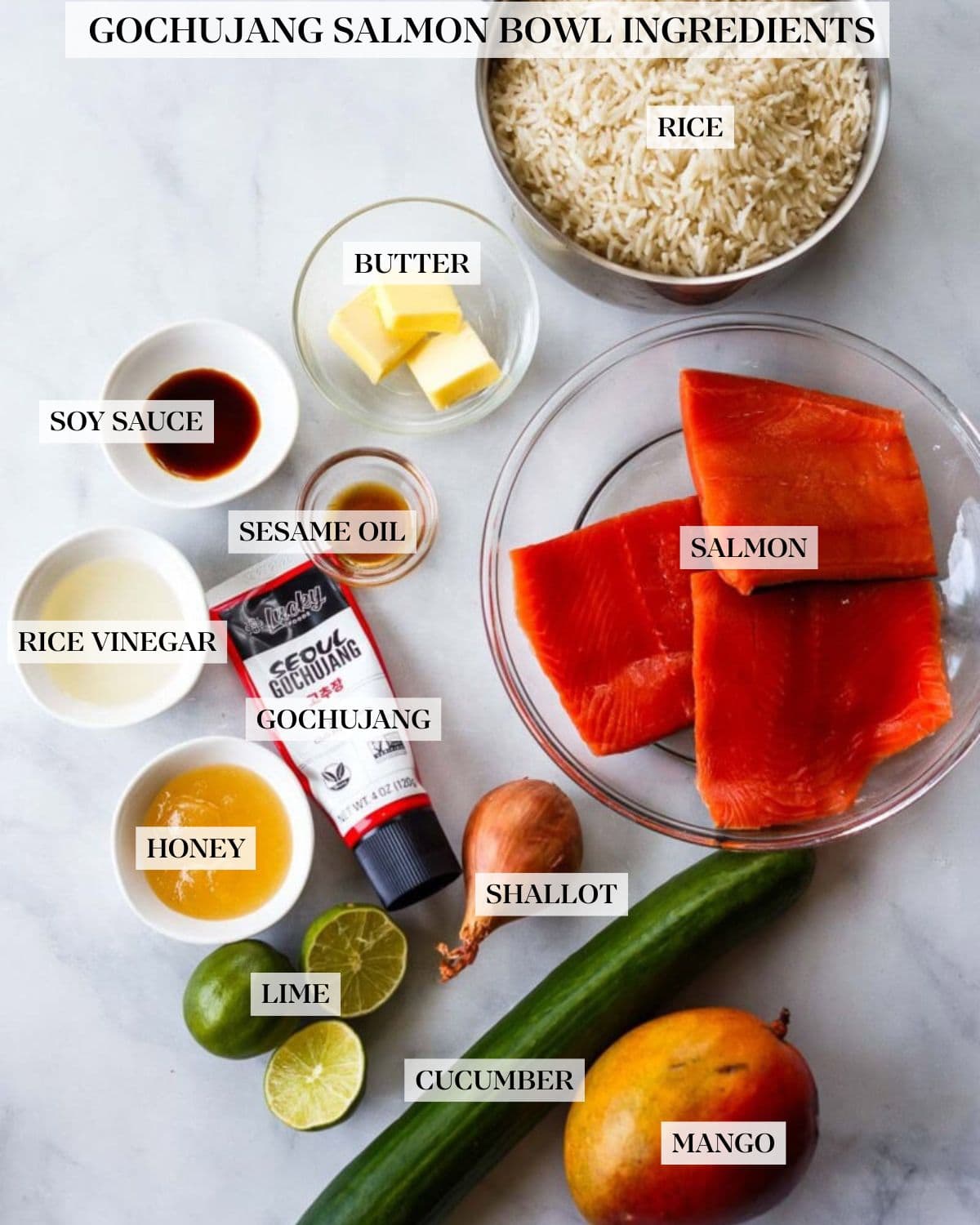
Gochujang Salmon Ingredients
- Salmon: Use skinless wild-caught salmon fillets for the best health benefits.
- Sticky Gochujang sauce: Shallot, gochujang paste ( or sub gochujang sauce) , honey, rice vinegar, low sodium soy sauce, sesame oil, and unsalted butter. Feel free to use gluten-free liquid aminos.
- Mango: Adds the perfect tart complement.
- Cucumber: use Persian cucumber, English cucumber or other thin-skinned varieties.
- Green onion: For a pungent, savory kick.
- Rice wine vinegar, honey, and lime juice: Uplifts the mango and cucumber, adding acidity, sweetness, and tang.
- Korean red pepper flakes: Or red pepper flakes or Aleppo.
- Jasmine rice: The base of the bowl. For a lower-carb option, try cauliflower rice!
- Optional Garnish – scallions, cilantro, chives, chive blossoms and lime wedges.
Salmon Bowl Variations
- Make it in the air fryer! Place salmon pieces spaced out in the air fryer at 400°F for 5-6 minutes.
- Bake it in the oven. Place salmon on a parchment paper-lined baking sheet and bake at 425°F for 8-10 minutes (baking time varies depending on the thickness of the fillets).
- Add veggies: Edamame and broccoli are great vegetables to add.
- Make it vegan. Use our crispy tofu recipe and sub vegan butter!
- Extra topping ideas: Try chive blossoms, toasted sesame seeds, or nori strips. For spicier salmon bowls, add sriracha or spicy mayo for an extra kick of flavor.
- Double the sauce: If you prefer your bowls extra sticky and saucy, double the sauce.
- Serve over any rice or grain. Black rice, quinoa, brown rice, coconut rice, white rice, cauliflower rice, or sushi rice are all good choices.
How to Make Gochujang Salmon Bowl
1. Cook the rice. Prepare our Coconut Rice or Jasmine Rice.
2. Make the quick mango cucumber salad. Add mango, cucumbers, scallions, salt, rice vinegar, honey, lime juice, and red pepper flakes to a bowl and toss.
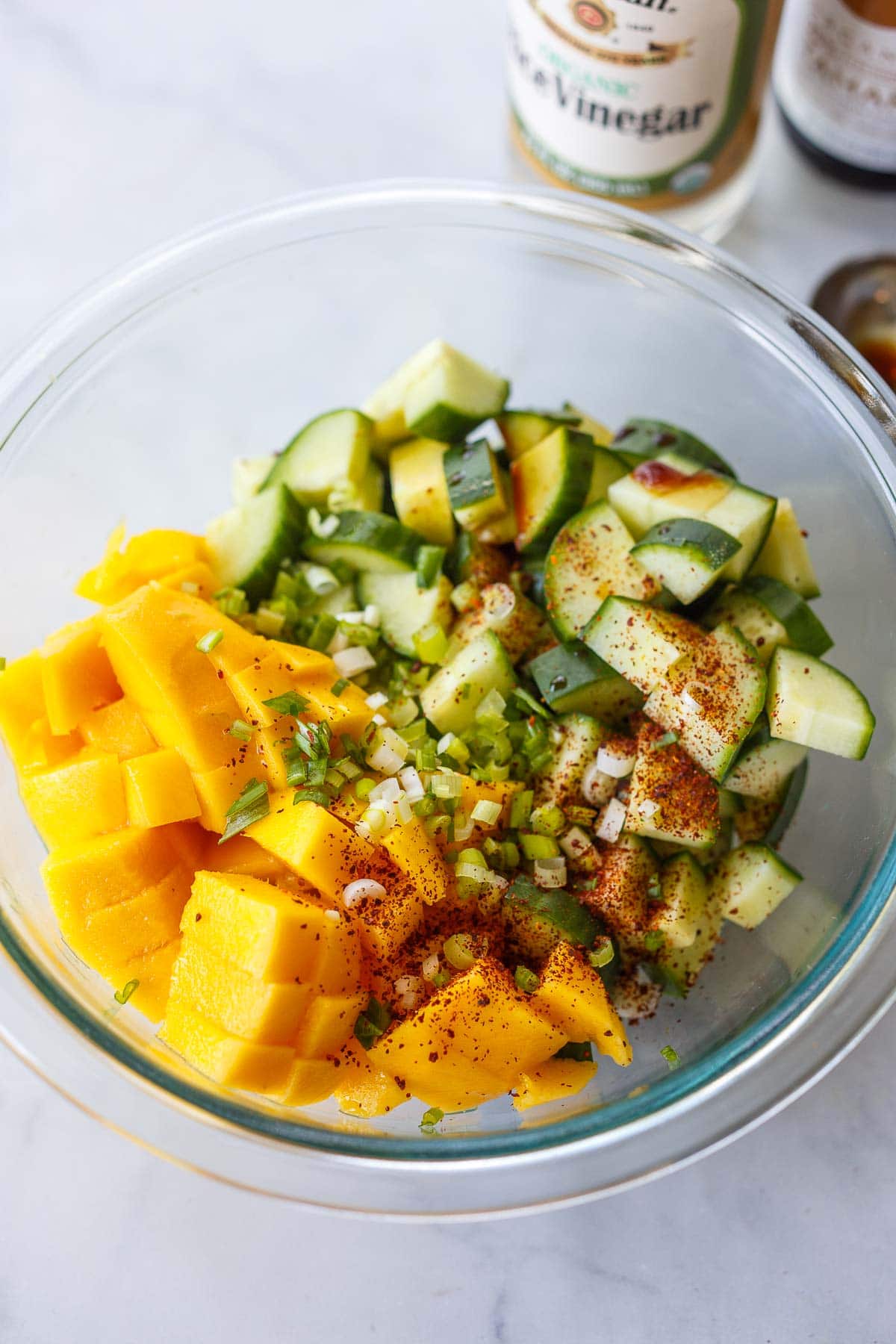
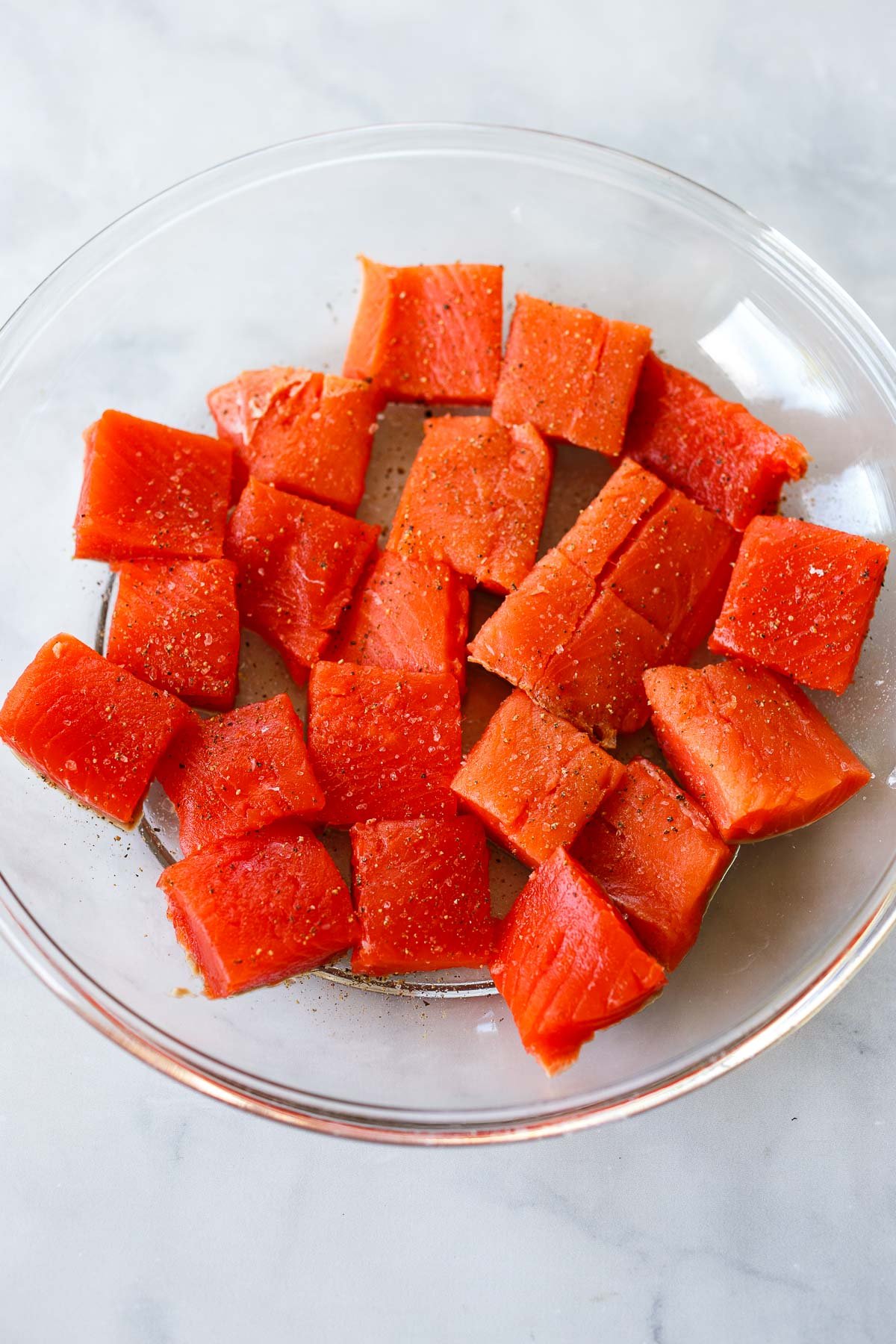
3. Cut and season the salmon filets. Cut the salmon into 1-inch cubes, pat dry and season with salt and pepper.
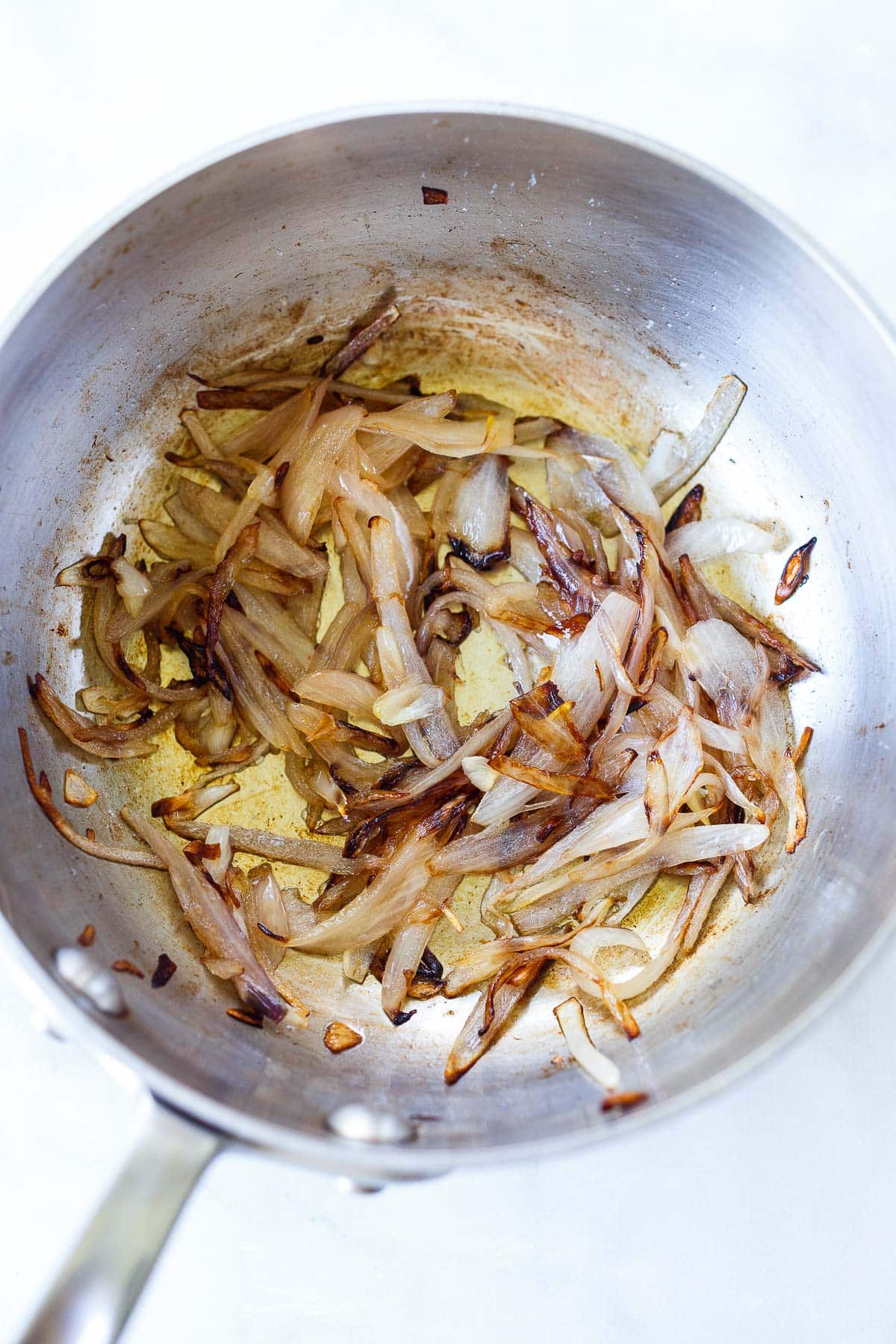

4. Make the gochujang glaze. Sauté shallot in a small saucepan for one minute, then add gochugaru, honey, rice vinegar, soy sauce, and sesame oil. Whisk continuously over medium high heat for 1-2 minutes until thick. Remove from the heat, add the butter, and whisk until well incorporated, and leave it in the pan.
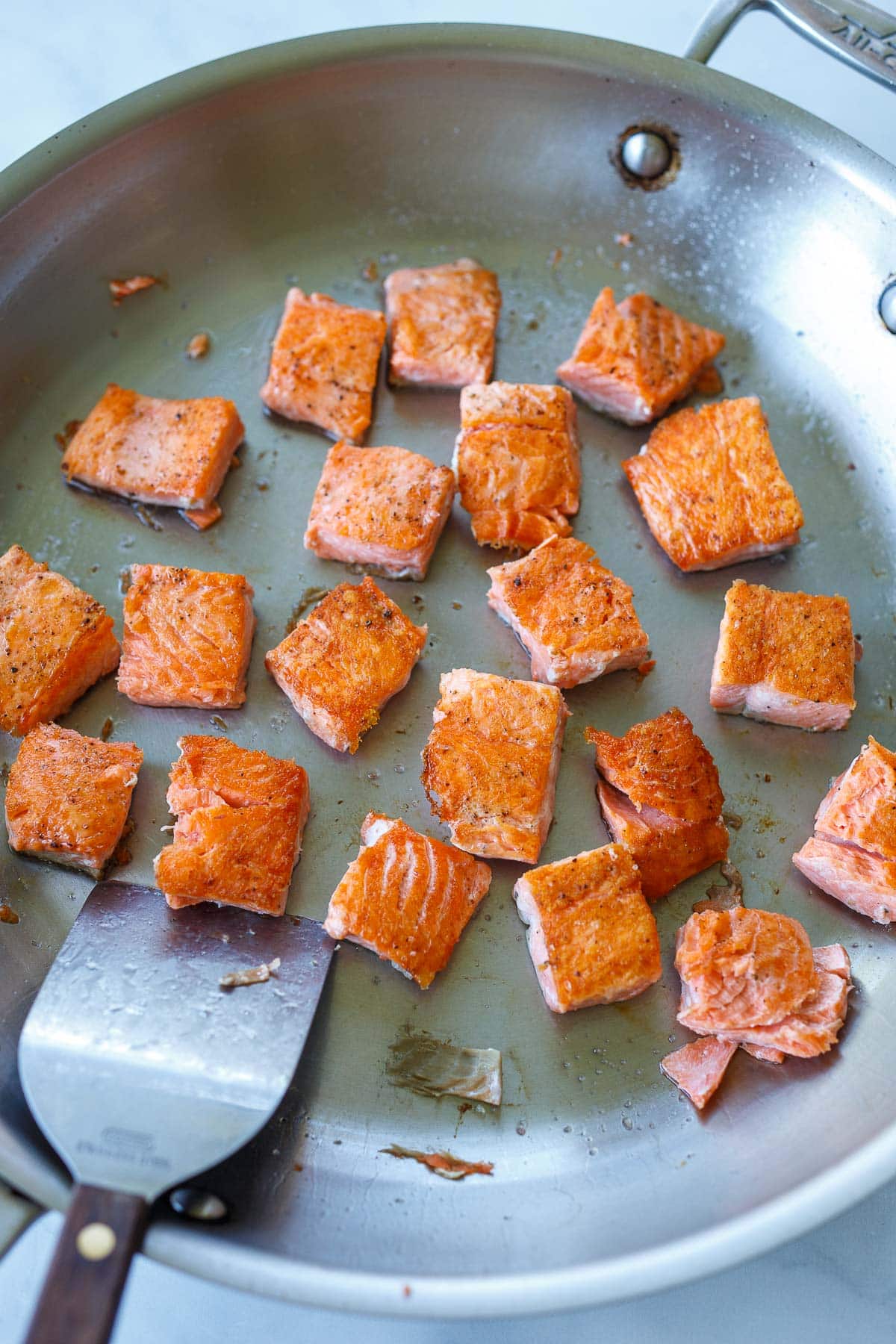
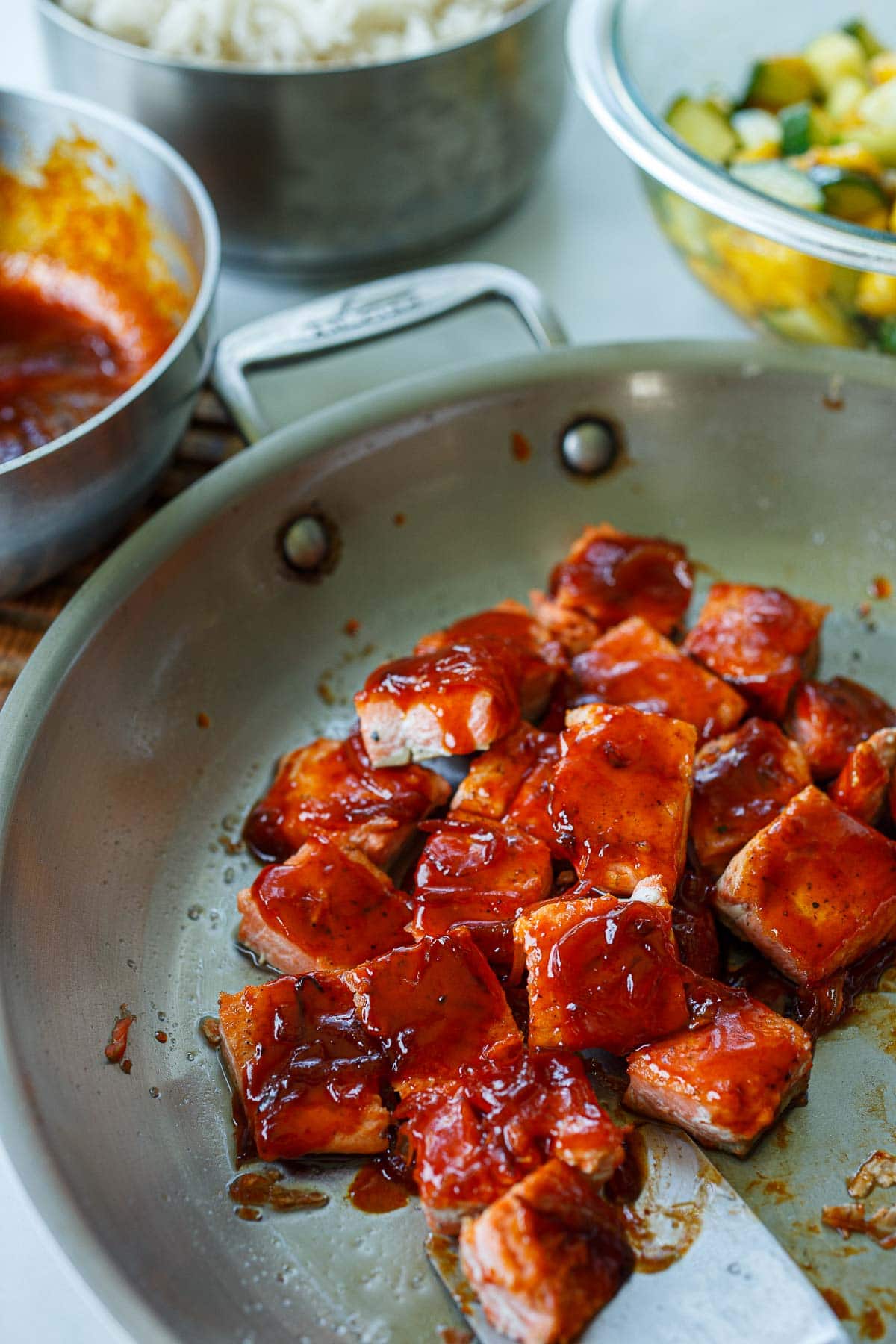
5. Sear the salmon. In a large skillet, heat oil over medium heat. Once hot, sear each seasoned salmon fillet for a few minutes. Flip to sear on the other side. Turn off heat. (See notes for air fryer and baking instructions.)Reheat the sauce if needed to loosen and warm, then drizzle the sauce over the salmon pieces and toss to coat.
6. Assemble the bowls. Divide the rice, gochujang salmon, and mango-cucumber salad among four bowls. Add avocado slices, scallions, and fresh cilantro if desired.
Chef’s Pro Tips
- Cut the salmon evenly: Cut the salmon into 1-inch cubes for uniform cooking.
- Pat the salmon dry: Pat dry to achieve a better sear and prevent steaming.
- Make the sauce ahead of time: Meal prep the sticky sauce up to 3 days ahead of time for quicker assembly on busy nights. Store in the fridge.
Storage
Store leftovers in the refrigerator in a separate airtight container for up to 3 days. The mango cucumber salad is best consumed within 24 hours. Reheat the salmon and rice separately to avoid overcooking the fish.
Serving Suggestions
While this salmon bowl makes a satisfying meal on its own, there are a variety of dishes that can be served alongside the bowls, or even added on top!
- Chili Crisp Cauliflower
- Korean Cucumber Salad
- Stir-Fried Pea Shoots
- Grilled Bok Choy
- Pan-Seared Turnips
- Asparagus Stir Fry
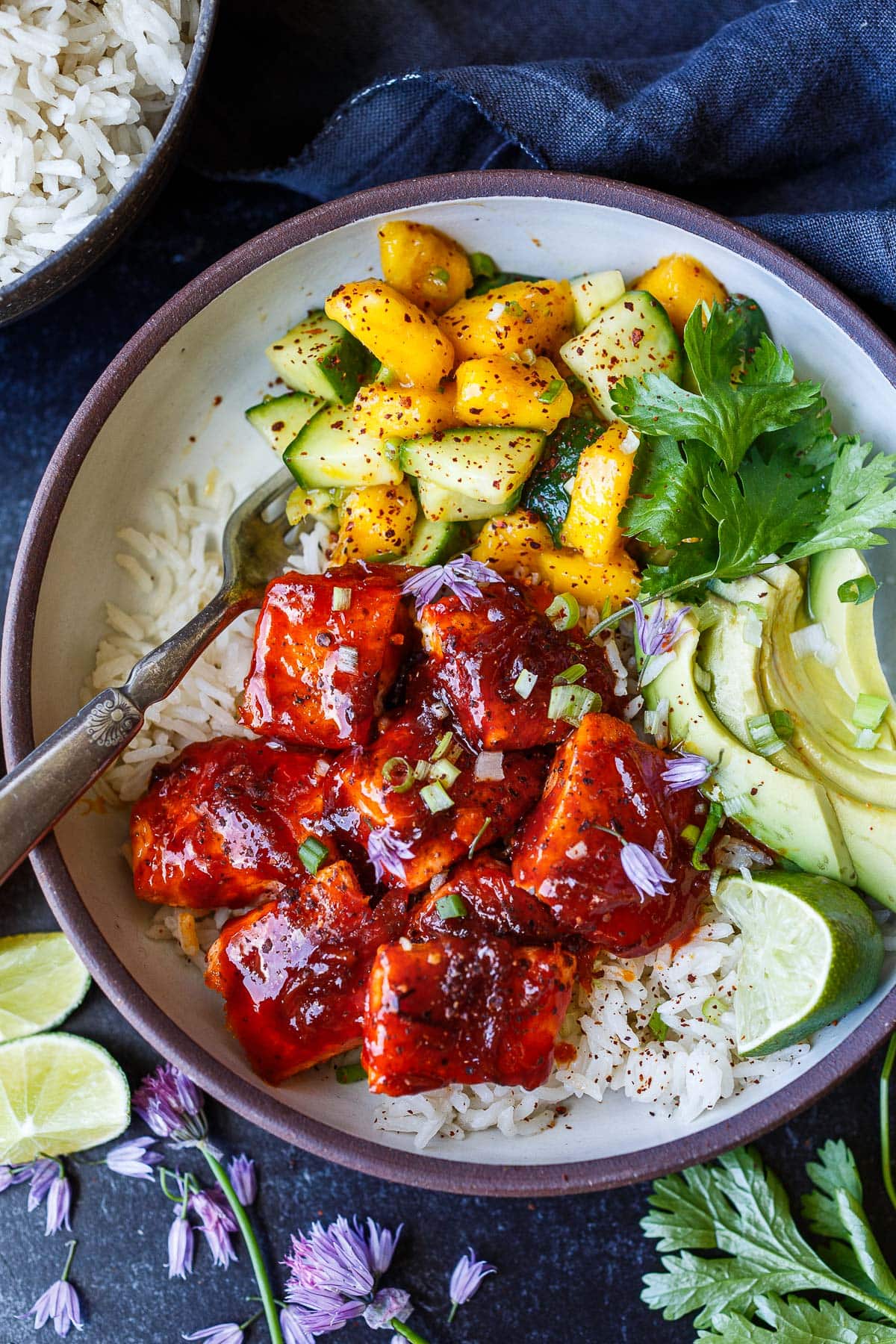
This Gochujang Salmon Bowl is so satisfying and nourishing! Let us know what you think in the comments below, hopefully with a 5-star rating!
More Asian Bowl Recipes!
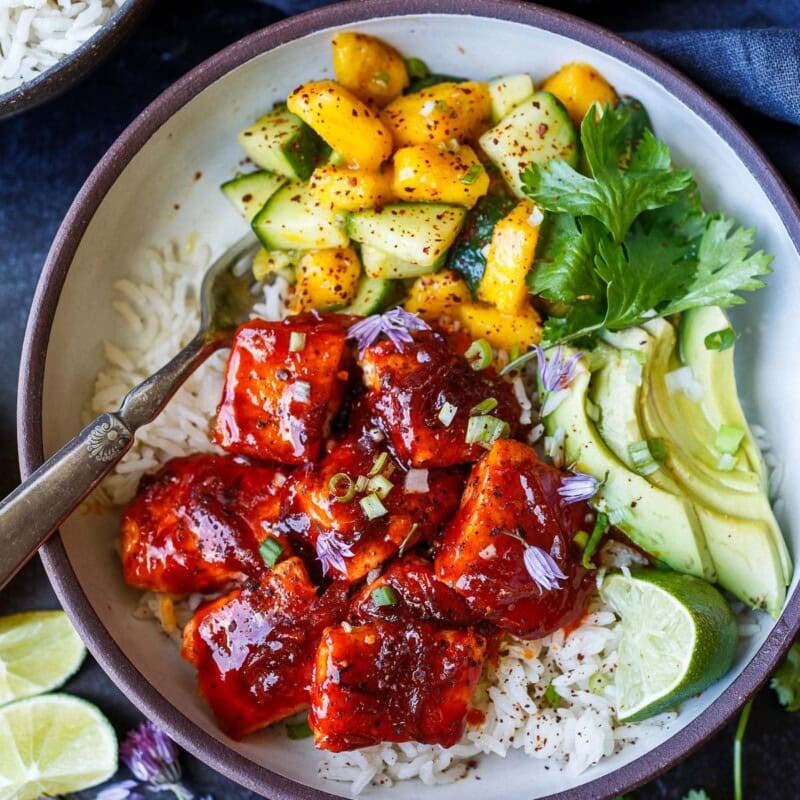
Sticky Gochujang Salmon Bowl
- Prep Time: 25
- Cook Time: 15
- Total Time: 40 minutes
- Yield: 4 bowls 1x
- Category: Bowls, Salmon recipes, Korean recipe, weeknight dinner, dinner ideas
- Method: stovetop, oven, air fryer,
- Cuisine: Korean
Description
Sticky gochujang salmon, fresh mango-cucumber salsa, jasmine rice, and avocado come together in this bold, healthy Korean-inspired bowl.
Ingredients
Jasmine Rice (makes 3 cups)
- 1 cup jasmine rice
- 1 1/4 cup water or broth
- 1/2 teaspoon salt
- 1 teaspoon olive oil
Mango Cucumber Salad
- 1 mango, cut into small cubes
- 2 cups cucumber, cut into small cubes (we like English, Turkish or Persian cucumbers or other thin-skinned varieties)
- 1 green onion, sliced
- 1/4 teaspoon salt
- 2 teaspoons rice vinegar
- 1 teaspoon honey
- 1 tablespoon lime juice
- 1/2 teaspoon Korean pepper flakes (red pepper flakes or Aleppo can substitute)
Gochujang Sauce
- 1 shallot, sliced into thin strips
- 2 tablespoons gochujang paste or gochujang sauce
- 2 tablespoons honey
- 2 tablespoons rice vinegar
- 1 teaspoon low-sodium soy sauce (or gluten-free liquid aminos)
- 1 teaspoon sesame oil
- 1 tablespoon unsalted butter
Salmon
- 8–10 ounces of salmon fillets, skinless
- salt and pepper to taste
- 1 tablespoon olive oil or coconut oil for searing.
Optional Garnishes – scallions, cilantro, chives, chive blossoms and lime wedges.
Instructions
- Set the rice to cook. Rinse the rice several times and then strain it. Place water, salt, oil in medium saucepan with the lid on (for faster boil and less evaporation) and bring it to boil. Stir in the rice, replace the lid and get it back to a boil. Lower heat to medium-low, and cook on a low simmer for 12 minutes. Turn the heat off, do not remove the lid, and let it sit for 10 minutes covered. Fluff and serve. See Jasmine Rice for more details.
- Make the mango salad. In a medium bowl toss together cut mango, cucumbers, scallions, salt, rice vinegar, honey, lime juice, and pepper flakes. Refrigerate.
- Make the Gochujang Sauce. In a small saucepan, sauté shallot for a minute, add gochujang paste, honey, rice vinegar, soy sauce, and sesame oil. Whisk together and stir constantly over medium-high heat for about 1-2 minutes; the mixture will thicken. Remove from heat and add butter, whisking it in until fully incorporated. Leave it in the saucepan.
- Cook Salmon. Pat the salmon dry and cut it into 1-inch cubes. Season lightly with salt and pepper. Heat oil in a large skillet over medium heat. Once hot, sear the seasoned salmon for a few minutes. Turn over to sear the other side. Turn the heat off. (See notes for baking or air-frying.)
- Reheat the sauce if necessary to loosen and warm it. Drizzle over salmon chunks and toss to coat.
- Assemble the bowls. Divide the rice, salmon, and mango salad among four bowls. Add avocado slices, scallions, lime wedges and fresh cilantro if desired. Serve immediately.
Notes
Nutrition
- Serving Size: -4 bowls ( with ¾ cup rice)
- Calories: 410
- Sugar: 18.1 g
- Sodium: 187.9 mg
- Fat: 8.6 g
- Saturated Fat: 2.8 g
- Carbohydrates: 60.8 g
- Fiber: 1.5 g
- Protein: 23.6 g
- Cholesterol: 51.1 mg
FAQs
Our Korean-inspired salmon bowls are served with a sticky gochujang sauce, mango cucumber salad, avocado, scallions, and cilantro.
There are so many different ways to prepare salmon, but for this Korean bowl, we use a sticky sauce made with shallot, gochujang paste, honey, rice vinegar, low sodium soy sauce, sesame oil, and unsalted butter.
We sear the salmon with a simple rub of salt and pepper to enhance the flavor. The sticky sauce is sweet and spicy!
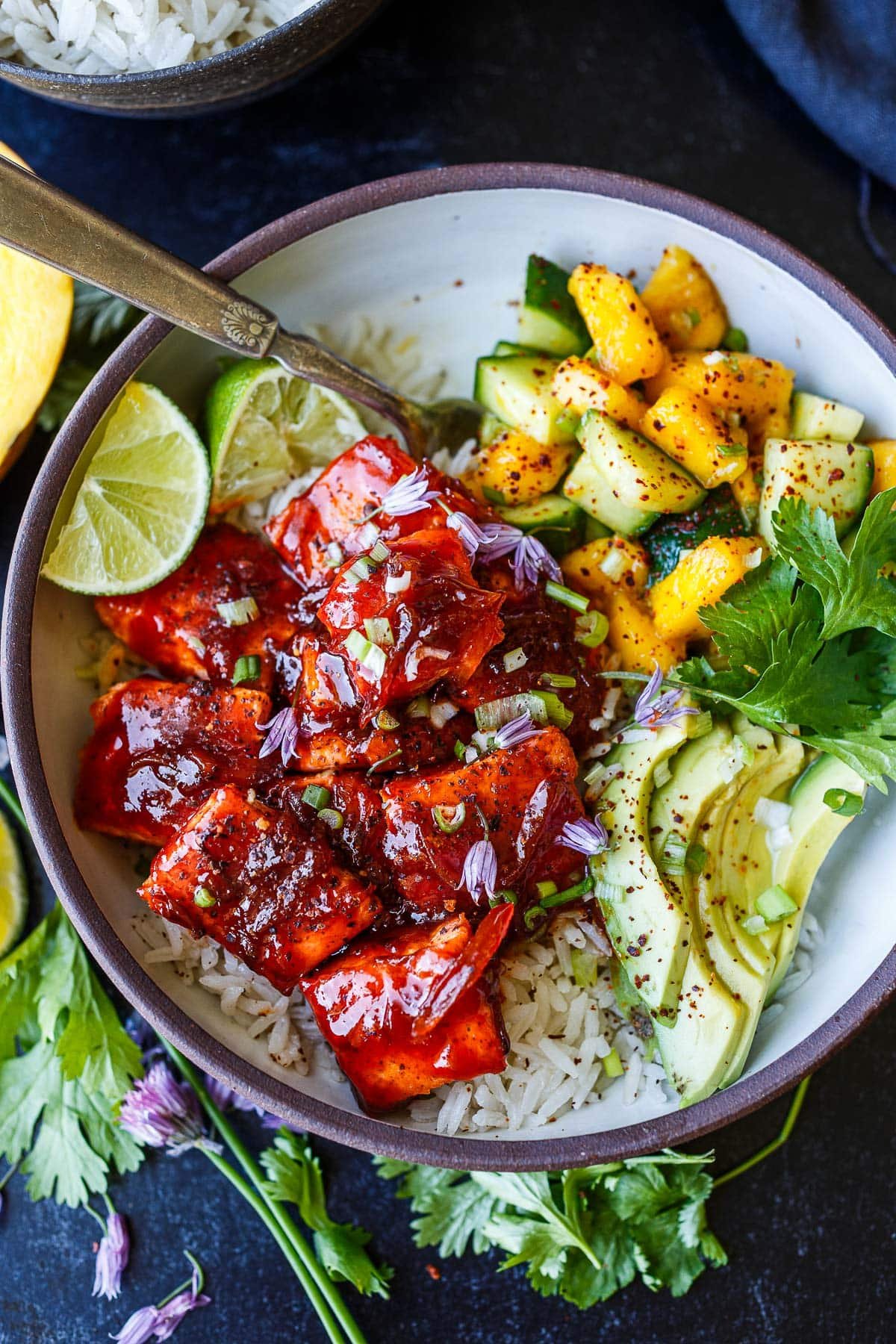
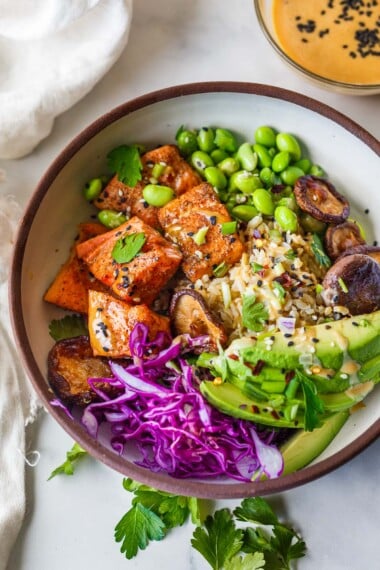
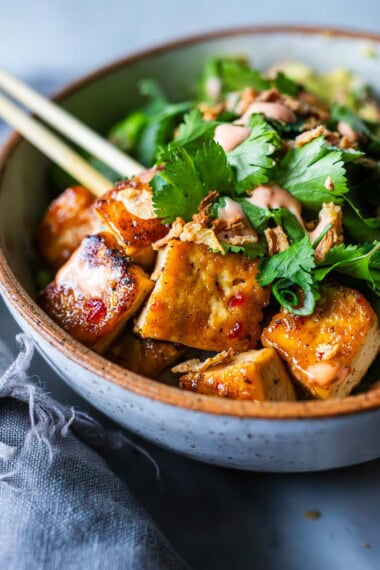
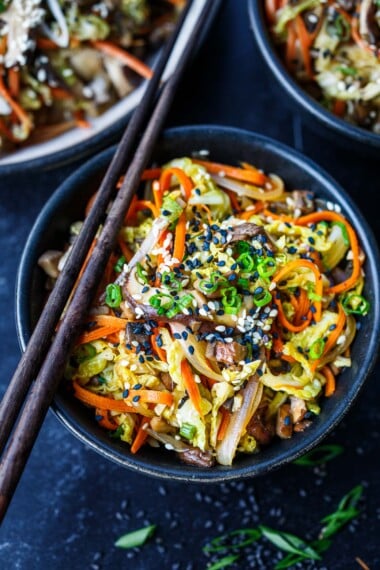
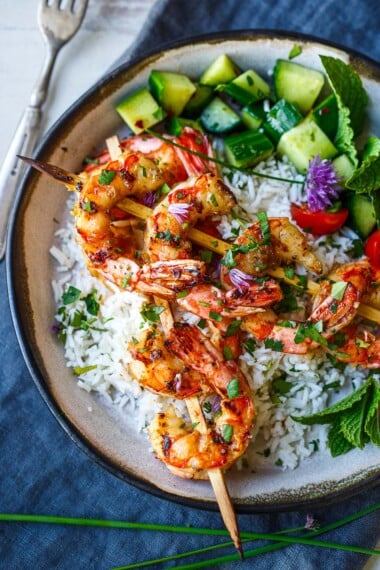

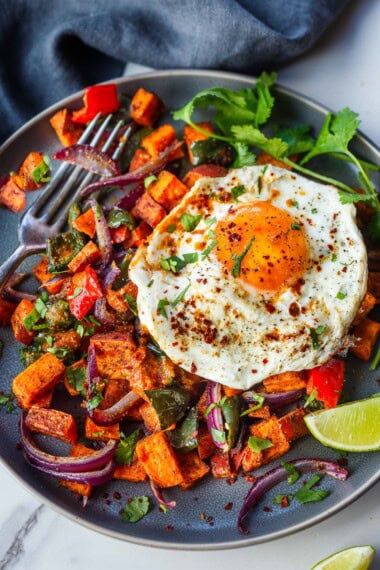
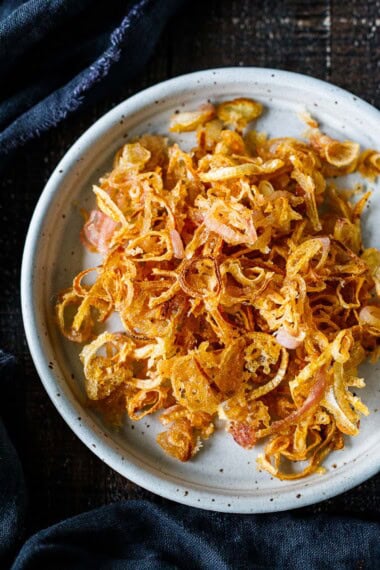



Delicious recipe. Perfect balance of sweet and spicy and tart on the salmon. And loved the mango cucumber salad!
Great to hear!
Hello, are there 8 – 10 salmon to distribute among the 4 bowls or are they 3 salmon fillets as seen in the image of 8 – 10 oz each?
Hi Marina, 8-10 ounces of salmon is divided among the 4 bowls.
This recipe is amazing! I’ve made it twice this week. Love the contrast of the fresh mango cucumber salad with the spicy sauce on the salmon.
Your sauces are magic — they elevate every dish.
Thanks Amy, so nice to hear you are enjoying!
Hi! There is a lot of mention of adding salt to the gochujang sauce, but there isn’t any listed in the ingredients.
Oops, no salt needed in the sauce. Thanks for the catch Nina! Recipe adjusted now. 🙂
Quick question…we live on the NC coast and husband catches a lot of fish (sheepshead, red drum)…could I use this instead of salmon?
Sure! I would give it try and let us know how it goes!
Well this looks fabulous!!! Such great flavors.
Thanks Mimi!
Delicious and easy to prepare
So glad you enjoyed!
Exceptional! I made this last night as I had almost everything on hand. The flavors were out of this world. Added edamame and doubled the salmon and sauce.
Awesome Sherri, so glad to hear this! Thanks for taking time to leave a review.